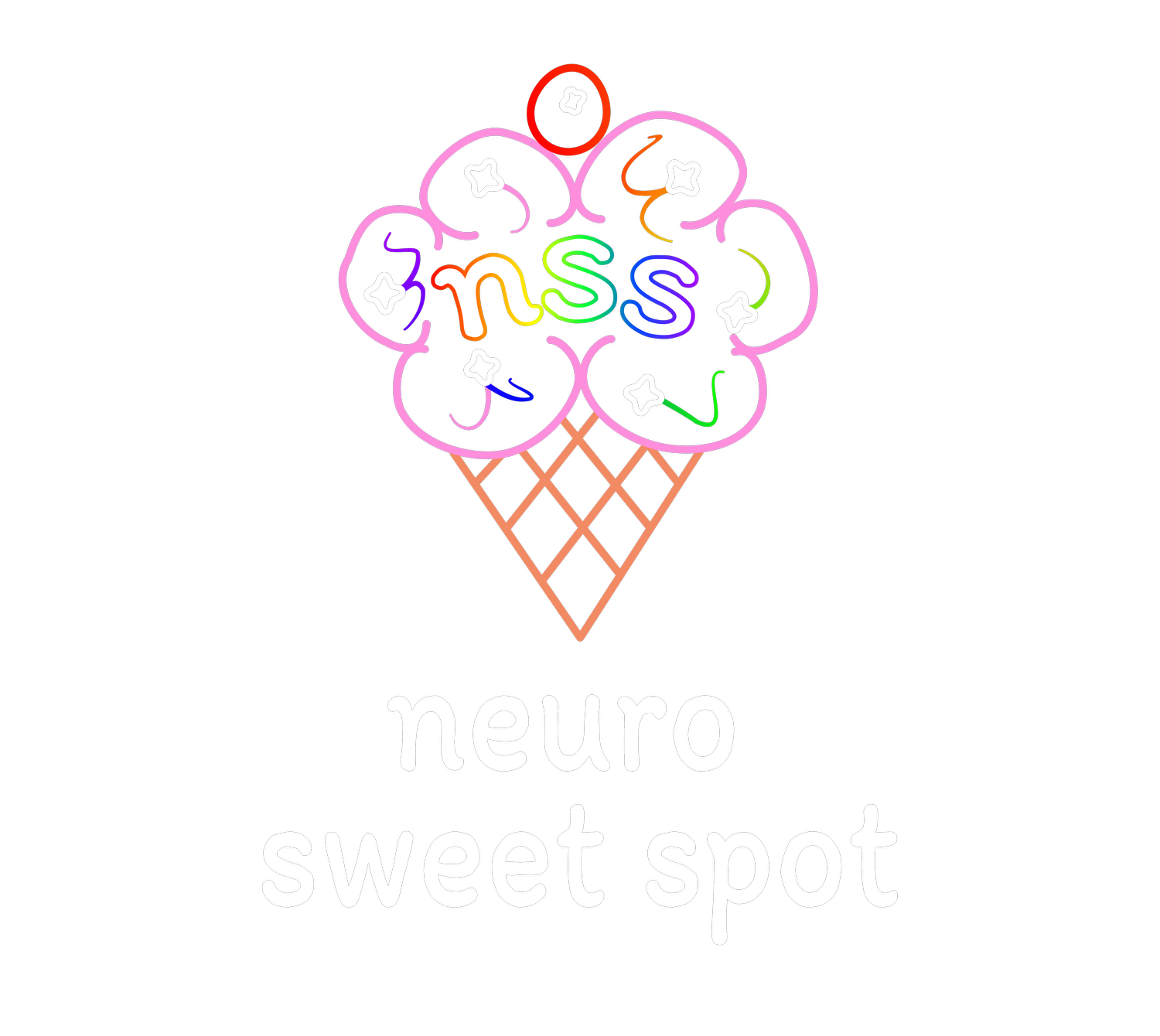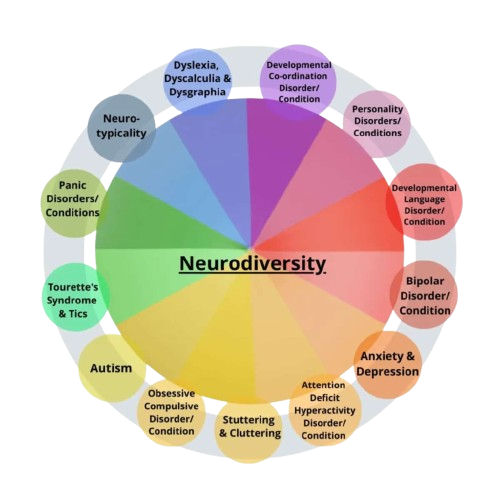
Education and Tools for Parents Learning about Neurodivergence For Their Kids
What Are You Calling My Child?: Understanding Neurodivergence
Neurodiversity is the natural variation in brain function in all humankind. In my practice I like to describe it as “rainbow brains,” and everyone has a unique “color” of brain.
‘Neurodivergent’ is a term we use to talk about individuals with variations of brains, referring to ‘neuro = brain’ and ‘divergent = different’ but it can be misleading.
Just like we don’t look at the rainbow and think that all the colors should be blue, we appreciate all the unique colors in all the hues and variations.
Orange is supposed to be orange, and red is supposed to be red, and none of them are a “divergent blue.”
Same with brains. Supposedly there is a “neurotypical” brain, but you see me putting quotes around that assessment of one category of brain type. It’s a ‘blue brain,’ it’s not the holy grail of brains.
(But the whole world has been built with that one type as the “blueprint” – so now the rest of us feel crazy because it’s literally not designed for us).
Some names (i.e. terms that are fundamentally tracking patterned sensorimotor connections) that have come about to describe other categories (colors) of brains include:
ADHD, Autism, Dyslexia, Sensory Processing Disorders, Anxiety, Depression, PTSD, OCD, Bipolar, Schizophrenia, Borderline, etc (not to leave any out, simply because there’s so many terms and categories - if there are specific topics you’d like more info on, please contact me).
Image Source: MetaArXiv Preprints | Bridging Neurodiversity and Open Scholarship
License: CC BY 4.0 International
Just for context, the mental health field debates whether and how trauma-related conditions are included,
But the big picture? It boils down to how the nervous system processes Information from the world.
The labels both completely matter and don’t really matter in a myriad of ways, but what I think is most helpful in this conversation is this: the base level of what ‘neurodivergent’ is describing is how different nervous systems interact with the world - real and perceived.
The brain is in a black box of the skull, and the only way it knows what’s going on in the world is through the nervous system. So, of course, when we are discussing differences in nervous system patterns and reactions, it directly affects all aspects of how people communicate, focus, process information, and experience emotions.
Why Language Both Matters—and Doesn’t
Words shape how we see ourselves. Labels can help us understand and advocate—or they can be used to dismiss and limit.
Labels before learning about Neurodivergence can include: lazy, entitled, unmotivated, selfish, emotional, dramatic, dumb, annoying, etc.
example: learning these words applied to me allowed me to understand that I was a “zebra” not a “failed horse.” It empowered me to see I was not broken, but part of a whole pack, ——— just not the pack I’d always tried to be looking like without knowing it. (We will cover this in more depth later, but people mask as a defense mechanism to not get mistreated or feel shame, not because they inherently want to present as more neurotypical.)
It can feel like a fight to find the “right” words, but once you stop putting energy into that, you free up actual brainpower for things that will actually help you. I say to many clients “maybe you don’t know what flavor of neurodivergent you are, but just allow yourself to explore your actual nervous system, not the one you thought you had.”
That’s why language both matters and doesn’t matter at the same time.
The paradox: Knowing where you are not is very helpful to start to figure out where you actually are, so you can begin to navigate properly. Allowing yourself to explore other ways that might feel better to your system requires that you let go of the strict expectations of how you thought your system should be able to do it.
This is when you find supports that are actually a good fit, instead of telling yourself you shouldn’t need support for something so “easy.”
It’s All About the Nervous System
Every label under the neurodivergent umbrella? They all boil down to how our nervous system responds to the world.
Survival mode vs. feeling safe and calm—that’s the core of it.
The brain isn’t designed for nuance—it’s designed to keep you alive, not happy.
If my friend is upset with me, my brain reads it the same way it would read a lion chasing me.
My nervous system doesn’t know the difference.
ND brains tend to detect more threats (even just more sensory cues), even in everyday situations.
Which is why it’s frustrating when someone says, “It’s not loud in here,” while the fluorescent lights hum like an actual jet engine.
Brains Are Rainbows—Stop Trying to Be a “Blue Brain”
You have a specific place in the rainbow of brains—stop exhausting yourself trying to act like a blue brain if that’s not who you are.
When we mask, suppress, or try to fit into the wrong expectations, it leads to:
Exploding → Feeling shame → Avoiding/hiding → Exploding → Repeat
Neurodivergence isn’t about deficits. It’s about differences.
If you compare a bird and a fish and call one “defective” for not flying/swimming, you’re missing the point.
Nor is the flip side of “defective” perspective helpful either, thinking “we’re all struggling in some way so don’t make such a big deal about yours.”
Embracing the unique colors, while allowing for variation, truth, and yes, limitations, too.
I can’t do crowds but I love tedious fine-tuned work with my hands
Another person (ND or NT) can’t focus on the physical work for extended amounts of time but loves socializing and leading groups.
Different? Yes. Valuable? Yes. Limited in some ways? Yes.
No. Not broken.
Sometimes validation feels like it goes in circles, get used to it.
Why Does It Matter to Know What Kind of Brain I Have?
Imagine calling a zebra a “defective horse.”
Imagine expecting a fish to climb a tree.
Understanding your brain helps you work with it instead of against it.
If Any of These Sound Familiar, This Might Be for You
You’ve been called:
lazy
a procrastinator
dramatic
too sensitive
rude
entitled
You’ve been told:
“Don’t be so sensitive.”
“Get over it.”
“You’re overreacting.”
“You’re over thinking it.”
These are often shame-based messages, even when they’re meant to provide perspective or motivation.
We can find a more helpful approach - helps us ask the right questions
Moving from: “This shouldn’t be hard for you.” - shame based, minimizing, distancing, shutting down and exacerbating negative spiral
Moving to: “What about this is making it so hard? What could make it a little bit easier?” - connection seeking, validating, actually helpful
The Tough Truth: It’s Not About Blame—It’s About Understanding
If you’ve ignored or minimized your emotions, it’s probably because other things felt more urgent.
That’s real. That’s valid. But ignoring emotions doesn’t make them go away.
The goal isn’t to disconnect and shut down—it’s to find balance.
You can be in the middle of a storm and still feel grounded, but that takes:
Self-awareness
Understanding how your nervous system works
Using the right tools to regulate
Our Nervous System Reads Feelings—Not Facts
Your brain doesn’t directly experience the world. It only knows what your nerves tell it.
If someone’s experience of a situation is different than yours, it doesn’t mean they’re “wrong”—it means their nervous system is giving them different data.
This is why validating someone’s experience is so important—it acknowledges their actual reality.
All Behavior Serves a Function
People do things for a reason—even behaviors that seem irrational or unhelpful.
When survival patterns become too rigid, they cause more harm than good.
Even things that are supposed to be rigid (like steel) break if they’re too stiff.
Flexibility is key.
Hard Things Aren’t Always Bad
Struggle isn’t always a sign that something is wrong.
School is hard. Exercise is hard. But in balance, these challenges help us grow.
Trauma research shows that playing Tetris after a stressful event helps the brain process it more effectively.
It keeps brain functions moving in an adaptable way.
Just like physical recovery after an injury, mental recovery needs movement too.
The brain is always learning patterns.
If you repeat unhealthy patterns, it gets better at those.
If you repeat healthy ones, it strengthens those instead.
key is not shaming the old patterns trying to help us, but understanding them and reaching for more helpful approaches when we notice (hence awareness is key!)
Validation First, Then Problem-Solving
Step 1: Validate the experience.
Their distress is real (even if the threat isn’t).
Step 2: Identify the need behind the behavior.
No one reacts “for no reason.” The nervous system is trying to get a need met.
Step 3: Help find a healthier way to meet that need.
But only after regulation.
Logic doesn’t work when the nervous system is in panic mode.
The Flashlight in the Forest Analogy
The fear of validating big emotions is that it feels scary and like “giving up.”
But validation isn’t surrender—it’s the starting point.
Quick version: Picture a dark forest.
Saying “it’s not dark” doesn’t help.
Saying, “you’re right it’s dark never go in there ” doesn’t help either.
What helps? A flashlight.
Tools only work if we actually use them.
For Full Version Click Here (Article link to come*)
What Else Goes in the Bag? (Article link to come*)
The tools you need depend on what your nervous system is asking for.
But before anything else—regulation comes first.
If you skip that step, nothing else will stick.
Key Takeaways
Neurodivergence is about how the brain processes the world, not about deficits in labels.
Validation is the first step to regulation.
Nervous systems are always learning— learn to train it in the direction that actually helps instead of digging deeper.
If the world feels overwhelming, you don’t necessarily* need to run—you need a reliable flashlight (tools to handle it).
knowing you can get to safety when you need to, though, is very important


